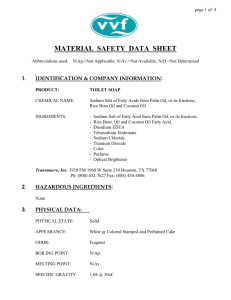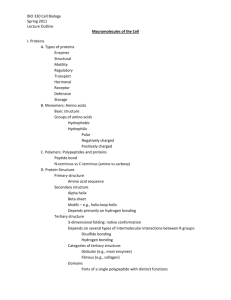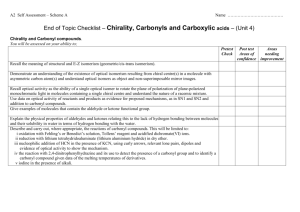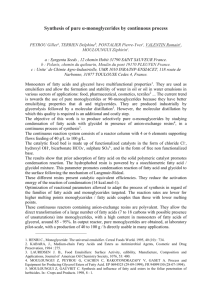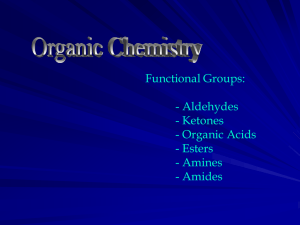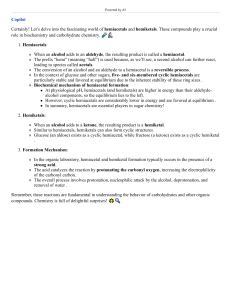Exam #4 Review Sheet CHEM 2124 Spring, 2014
advertisement
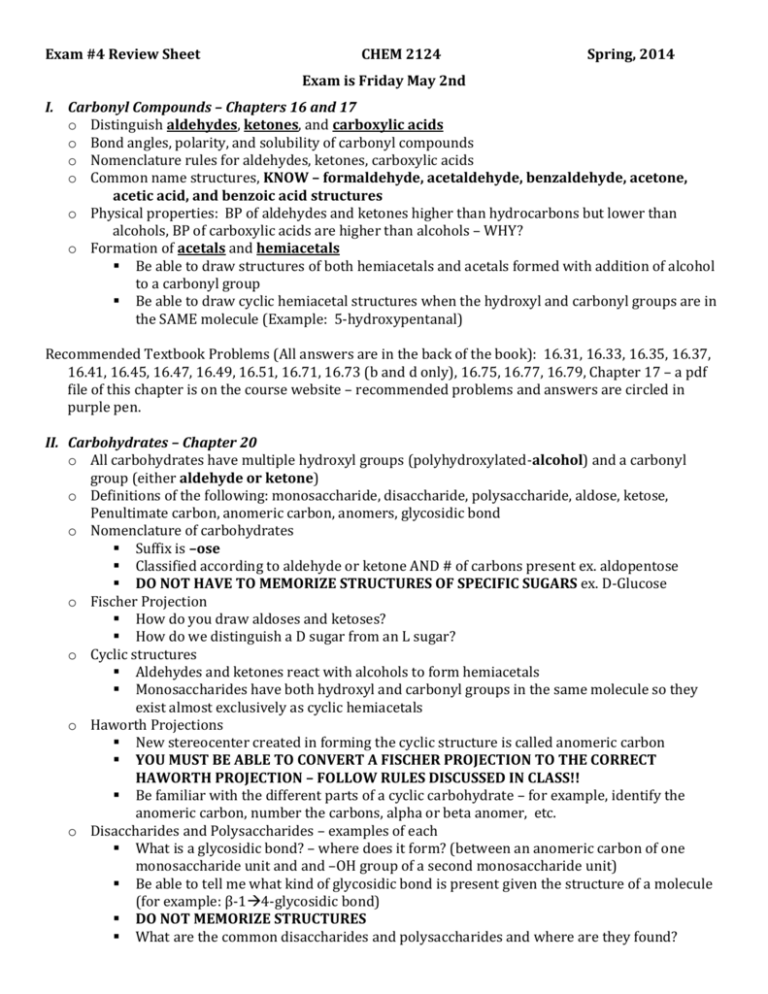
Exam #4 Review Sheet CHEM 2124 Spring, 2014 Exam is Friday May 2nd I. Carbonyl Compounds – Chapters 16 and 17 o Distinguish aldehydes, ketones, and carboxylic acids o Bond angles, polarity, and solubility of carbonyl compounds o Nomenclature rules for aldehydes, ketones, carboxylic acids o Common name structures, KNOW – formaldehyde, acetaldehyde, benzaldehyde, acetone, acetic acid, and benzoic acid structures o Physical properties: BP of aldehydes and ketones higher than hydrocarbons but lower than alcohols, BP of carboxylic acids are higher than alcohols – WHY? o Formation of acetals and hemiacetals Be able to draw structures of both hemiacetals and acetals formed with addition of alcohol to a carbonyl group Be able to draw cyclic hemiacetal structures when the hydroxyl and carbonyl groups are in the SAME molecule (Example: 5-hydroxypentanal) Recommended Textbook Problems (All answers are in the back of the book): 16.31, 16.33, 16.35, 16.37, 16.41, 16.45, 16.47, 16.49, 16.51, 16.71, 16.73 (b and d only), 16.75, 16.77, 16.79, Chapter 17 – a pdf file of this chapter is on the course website – recommended problems and answers are circled in purple pen. II. Carbohydrates – Chapter 20 o All carbohydrates have multiple hydroxyl groups (polyhydroxylated-alcohol) and a carbonyl group (either aldehyde or ketone) o Definitions of the following: monosaccharide, disaccharide, polysaccharide, aldose, ketose, Penultimate carbon, anomeric carbon, anomers, glycosidic bond o Nomenclature of carbohydrates Suffix is –ose Classified according to aldehyde or ketone AND # of carbons present ex. aldopentose DO NOT HAVE TO MEMORIZE STRUCTURES OF SPECIFIC SUGARS ex. D-Glucose o Fischer Projection How do you draw aldoses and ketoses? How do we distinguish a D sugar from an L sugar? o Cyclic structures Aldehydes and ketones react with alcohols to form hemiacetals Monosaccharides have both hydroxyl and carbonyl groups in the same molecule so they exist almost exclusively as cyclic hemiacetals o Haworth Projections New stereocenter created in forming the cyclic structure is called anomeric carbon YOU MUST BE ABLE TO CONVERT A FISCHER PROJECTION TO THE CORRECT HAWORTH PROJECTION – FOLLOW RULES DISCUSSED IN CLASS!! Be familiar with the different parts of a cyclic carbohydrate – for example, identify the anomeric carbon, number the carbons, alpha or beta anomer, etc. o Disaccharides and Polysaccharides – examples of each What is a glycosidic bond? – where does it form? (between an anomeric carbon of one monosaccharide unit and and –OH group of a second monosaccharide unit) Be able to tell me what kind of glycosidic bond is present given the structure of a molecule (for example: β-14-glycosidic bond) DO NOT MEMORIZE STRUCTURES What are the common disaccharides and polysaccharides and where are they found? What are the polysaccharides that comprise starch? Recommended Textbook Problems (All answers are in the back of the book): 20.27, 20.29, 20.31, 20.33, 20.37, 20.39, 20.41, 20.45, 20.47, 20.49, 20.63, 20.65, 20.67 (a through d only), 20.69, 20.73 III. Lipids – Chapter 19 o What are lipids? o What are the structural commonalities of all lipids? o Definitions: Hydrolyzable lipids, nonhydrolyzable lipids, fatty acids, saturated fatty acids, unsaturated fatty acids, triglycerides (triacylglycerols), simple triglycerides, mixed triglycerides, trans fats, saponification o KNOW THE STRUCTURE OF GLYCEROL o Hydrophilic and hydrophobic portions of fatty acids – given a fatty acid, find each part o How is melting point of fatty acids related to the fatty acid structure? o Reaction for the formation of a triacylglycerol given fatty acid structures o What is a soap? Metal salts of fatty acids – formed through base hydrolysis of a triglyceride o Given the structure of a triglyceride and a metallic base, what is the structure of the soap formed? What is the other product that is formed? Recommended Textbook Problems (All answers are in the back of the book): 19.35, 19.37, 19.39 (a through d only), 19.55 IV. Amines – Chapter 18 o What is the functional group in an amine? o What is the structural difference between primary (1°), secondary (2°), and tertiary (3°) amines? o Shapes, bond angles, and physical properties of amines Polarity, hydrogen bonding, boiling/melting points (Ether<Amine<Alcohol), (Tertiary< Secondary<Primary) o Amine nomenclature: Primary amines – can use systematic (IUPAC) or common names Secondary and tertiary amines – Rules for compounds with identical vs. non-identical substituents Recall the structure of aniline What is the structure of an amino group? o Amines as bases – what happens when an amine is reacted with an acid? Why is this important in the world of medicine? How is the polarity of the molecule impacted in this reaction? o What is a quaternary ammonium salt? Recommended Textbook Problems (All answers are in the back of the book): 18.31, 18.37, 18.39, 18.41, 18.43, 18.47, 18.49, 18.53, 18.55, 18.57


